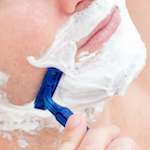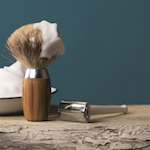The 5 Most Common Wet Shaving Mistakes And How to Avoid Them
Written by Advice Team on June 7, 2017
If you suffer from razor bumps, cuts or irritated skin after shaving, your daily ritual can turn into a real chore. But by adopting a proper shaving routine you can avoid common shaving mistakes and get the most out of your daily shave. Here are the five most common wet shaving mistakes we hear about and how you can avoid them…
1. Poor Preparation The phrase ‘fail to prepare and prepare to fail’ is oh so true when it comes to shaving. One of the main causes of irritation when shaving is poor (or even worse, no) preparation. Hacking away when your skin is dry and your stubble is stiff and bristly will inevitably lead to an uncomfortable shave and sore post-shave skin.
The quickest way to prep your skin for a quality shave is to have a warm shower and to use a light exfoliator. The steam from the shower will open your pores and soften your stubble and the exfoliator will remove unnecessary oil and dead skin cells and will prime your skin. The longer you allow the steam to penetrate your beard the softer the hair will become, which makes it easier to cut.
2. Dull Blades Using dull blades is probably the biggest shaving faux pas. Using a poor quality razor and blunt blades is a recipe for pain, as the dull blades won’t cut cleanly through the hair and will drag and skip, pulling and damaging your skin and increasing the potential for nicks and cuts and razor burn. In addition blunt blades will require you to make more passes over the same area to get a close shave and the more passes you make, the higher the chances are of skin irritation.
A fresh set of sharp, clean blades will make all the difference when it comes to the quality of your shave. The lifespan of blades will depend on how thick and coarse your hair is along with whether you follow a good pre-prep routine (the softer the stubble the less work the blade has to do), but as a general rule of thumb replace your blades between every 3 to 5 shaves if you wet shave and between every 12 to 18 months if you use an electric shaver.
3. Cheap Lather Instant shaving foam from a can is the standard choice when it comes to lather, but these products often include parabens, sulfates, alcohols and preservatives. These chemicals not only cause irritation, especially when it comes to sensitive skin, but do nothing to nourish and protect your skin.
For the closest of shaves choose a glycerin-based shaving cream or soap over a foam or a gel. Massage the cream into your beard and let it sit for a few minutes to work soften your stubble. Ensure you get the cream right down to the surface of the skin, lifting and suspending the hairs in the cream in readiness for cutting. In addition a quality lather provides a protective layer between the blade and your skin, allowing the razor to glide smoothly across the face which will help reduce razor burn and redness and deliver a far more comfortable shave.
4. Poor Technique As with most things in life technique is everything. A poor shaving style is a one-way ticket to irritation, shaving rashes and ingrown hair so if you want a smoother, faster, more comfortable shave it’s time to hone your technique.
The key to a superior shave is to use slow, careful strokes and move methodically over your face in the direction of the grain, not against it. When you shave against the grain, the blade of the razor tugs at the hair, pulling it away from the skin before slicing through. The pulling of the hair away from the skin increases the risk of ingrown hairs, which can swell up into sore, unsightly razor bumps. With a good foam, and a sharp blade you needn’t press the razor against your skin; go gently and use a light touch.
5. Skipping Aftercare Shaving can irritate and dry your skin, so to ensure you have the smoothest and most comfortable post-shave skin, make sure you finish your shave correctly. Rinse your face with clean, cold water as it closes the pores and pat (don’t wipe) your face dry with a soft towel. If you have any nicks or grazes treat them with an alum block when rinsing to help heal the skin.
Finish with a moisturising post-shave balm to close your pores and re-hydrate your skin whilst having a cooling and calming effect. Choose a product that contains naturally-based ingredients like shea butter or aloe vera to will to soothe and restore your skin’s moisture and avoid any that contain alcohol as this dries and irritates skin even further.






